Dairy & Veal Production
1/78
There's no tags or description
Looks like no tags are added yet.
Name | Mastery | Learn | Test | Matching | Spaced |
|---|
No study sessions yet.
79 Terms
ARTIFICIAL INSEMINATION (AI)
introduction of semen passed through a straw and pipette into the cow’s reproductive tract for the purpose of achieving pregnancy
Bulk Tank
A large tank used for cooling and storing milk at a cold temperature until it can be picked up by a milk hauler for transport to a creamery
Bull
Male cattle that have not been castrated and are fertile.
Bull
Can be extremely dangerous and can cause serious injury or death to personnel when appropriate safety precautions are not taken when working around these animals
Calf
A young bovine, either male or female, up to one year of age
Clean-up Bull
A breeding bull that is used to naturally inseminate heifers and cows that do not become pregnant by means of artificial insemination
Colostrum
The first milk produced by a cow following calving.
Colostrum
has higher concentrations of proteins, fats, vitamins and antibodies (immunoglobulins) compared to milk that is used for human consumption
Proteins, Fats, Vitamins, Antibodies
Colostrum has these
Immunoglobulins
Proteins, Fats, Vitamins, Antibodies
Cull Cows
Cows that are removed from the herd for health or production reasons.
Dairy Calves
Female or male dairy cattle being fed a ration that includes milk or liquid milk replacer and which are not intended for veal production
Dairy Cows
Female dairy cattle that are intended for production of milk human consumption
Dry cow therapy or treatment
An intramammary antibiotic for administered into each teat at the beginning of the dry period to prevent udder infections during the dry period and/or treat active infections
Dry Dairy Cows
Female dairy cattle that had previously lactated, but which are not currently producing milk (i.e., cows that are between lactations)
Dry Period
Approximately two months before she is due to calve again, a lactating dairy cow stops getting milked and is allowed ~60 days to gain back weight that may have been lost during lactation; the udder is also able to repair and regenerate secretory mammary gland tissue during this time before the next calving and resumption of routine daily milking
Extra Label
Use of a prescription medication or supplement that is not in accordance with the directions on the manufacturer’s label. Extra label use can only be done by a producer under the direction of a licensed veterinarian with whom there is an established Veterinarian Client-Patient relationship
First Calf Heifer
After giving birth to its first calf, a replacement dairy heifer
Formula Fed Calf
A calf raised to about 16 to 18 weeks of age on an all liquid diet. Also called milk-fed or special-fed veal
Fresh Cows
Dairy cows that have recently calved.
Lactating Dairy Cows
Female dairy cattle that are producing milk.
Lactating Cow Treatment/Therapy
An intramammary antibiotic that is designed for use during the normal lactation period
Milk Fed Veal
A bull calf that is raised on milk replacer for about 16 weeks before slaughter
Non-formula Fed Veal
A calf that has been weaned from milk-replacer at about two months of age and has transitioned to a solid food diet of hay and/or grain.
Pre-ruminant
An animal with a rumen that is not yet anatomically or functionally mature
Replacement Dairy Bulls
Intact male dairy cattle intended for reproductive purposes such as natural breeding or for collection of semen for use in artificial insemination (AI)
Replacement Dairy Heifers
Female dairy cattle from the time of weaning until the time of first calving
Rumen
The largest compartment of the forestomach in a mature ruminant animal
Rumen
site of microbial fermentation that is required to produce useable nutrients from consumed feed materials that would otherwise be indigestible
Reticulum
Where is the rumen anatomically joined to
Reticulorumen
Precedes the next two compartments (omasum and abomasum)
Abomasum
Corresponds to the stomach of a human being
Paunch
Rumen
Honeycomb
Reticulum
Bible, Many Plies
Omasum
True Stomach
Abomasum
Teat Sealant
A paste that is infused into the end of each teat following dry cow treatment. Such products are used to seal the end of the teat to prevent introduction of infectious agents into the udder during the dry period.
Veal calves
Immature beef and dairy breed cattle that lack a functional rumen and that are intended for meat production.
Voluntary Waiting Period
A two to three month period of time following calving before which a cow is not rebred by AI or allowed to have exposure to a bull.
Weaning
The process of transitioning a calf away from a diet containing milk or milk replacer, to an all solid feed diet or ration.
Withdrawal Interval
Describes a withdrawal period for a drug that has been used in an extralabel manner.
Withdrawal Period
The period of time that is required to elapse following the administration of an approved animal drug before which milk can be sold for human consumption, and/or the animal can be slaughtered for human consumption.
Holstein Friesian
World's highest-production dairy animals
Famed for their large dairy production
averaging 22,530 pounds of milk per year
black and white or red and white in colour
typically exhibiting piebald pattern
Jersey
• British breed of small dairy cattle from the British Channel Island
• Highly productive – cows
• Give over 10 times their own weight in milk per lactation
• Milk is high in butterfat and has a characteristic yellowish tinge
• Ranges from only 400 to 500 kilograms (880 to 1,100 lb)lands
Ayrshire
• Red and white markings
• The red can range from a shade of orange to a dark brown
• Their milk production can reach 20,000 lb (9,100 kg) or greater per annum
Brown Swiss
• Medium size
• Coat is usually a light grayish brown, but varies from almost white to gray or dark brown
• There may some shading in the coat, with the forequarters often darker than the legs and hind parts
• Muzzle is black, ringed with creamy white
Guernsey
From the island in the Channel Islands
Fawn or red and white in colour, and is hardy and docile.
It produces rich and flavoursome milk, high in fat and protein, and has a golden yellow tinge due to its high βcarotene content
Holstein-Friesian
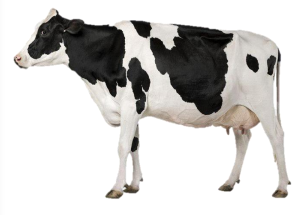
Jersey

Ayrshire
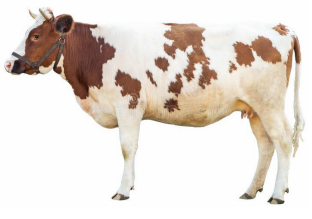
Brown Swiss

Guernsey
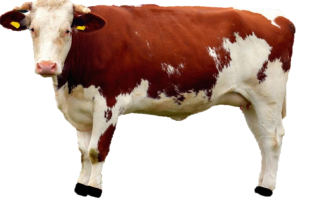
Holstein-Friesian, Jersey, Ayrshire, Guernsey, Brown Swiss
Breeds of Dairy Cattle
Conventional operations
feed grown on the farm or purchased elsewhere is brought to the cows. Typical examples of cow feed include hay (which is grown, cut, dried, harvested and baled in the field for later feeding to cows), and corn silage (which is made from chopped and fermented corn that is stored in silos or plastic bags before being fed to cows).
Conventional Operations
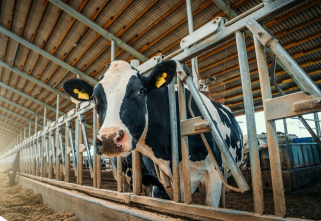
Grazing or Pasture operations
On these farms, rather than bringing the feed to the cow, the cows are brought to the feed in the pasture.
Grazing or Pasture operations
Many operations take advantage of intermittent pasture by allowing grazing when it is available and then feeding cows indoors during seasonal, inclement weather
Grazing or Pasture operations
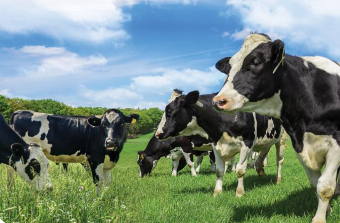
Conventional Operations, Pasture and Grazing Operations
Types of feeding and operations
Tie Stalls/Stanchion, Free Stall, Dry Lot
There are three major types of primary housing;
Tie Stalls/Stanchion
This housing type combines housing and milking at one location
Free Stall
In this type of housing there are individual stalls with metal pipe partitions between stalls, and cattle are not confined to one particular stall
Dry Lot
an outdoor pen typically augmented with shade structures
Tie stall/stanchion, Parlor
Two general types of milking facilities:
Tie stall/stanchion
cows are typically milked while standing in their individual stall
Parlor
Cows are walked multiple times per day to a dedicated milking area
Side Opening (Tandem) Parlor, Herringbone (Fishbone) Parlor, Parallel (Side by Side) Parlor, Rotary (Carousel; Turnstile) Parlor
TYPES OF MILKING PARLOR
Side Opening (Tandem) Parlor
Cows are milked from the side in this system. These are more suited to operations with up to about 400 cows where there is a high level of management and more individualized care for cows while in the parlorA
Side Opening (Tandem) Parlor

Herringbone (Fishbone) Parlor
In this system cows are milked while standing on an elevated platform in about a 45-degree angle facing away from the milker. In this system cows are milked from the side.
Herringbone (Fishbone) Parlor
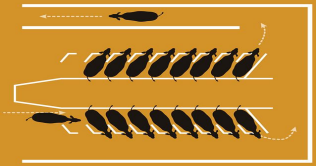
Parallel (Side by Side) Parlor
In this system cows stand on an elevated platform at a 90-degree angle facing away from the milker who must milk the cows from between the rear legs of the cow. The advantage to this system is that the distance between animals is shorter and reduces walking distance for the milkers
Parallel (Side by Side) Parlor
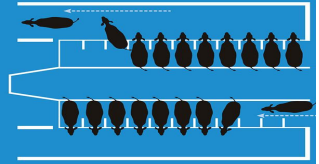
Rotary (Carousel; Turnstile) Parlor
➢In this type of parlor, cows move onto a rotating platform, facing either inward or outward depending on the system.
➢While this system is typically more costly to construct, the actual day to day milking procedures are more automated and more efficient.
➢As such, this system is best suited to large herds (>1000 cows). This system does not easily allow for individualized cow treatment
Rotary (Carousel; Turnstile) Parlor
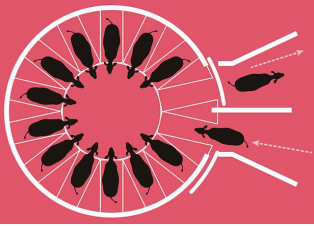
IDENTIFICATION
Keeping track of which dairy cows are healthy and profitable requires animal identification and accurate record keeping
Neck Chains/Collars, Leg Bands, Branding, Tattoos, Eartags
Types of Identification
Lactation
Begins immediately following calving.
Record Keeping
It is critically important for farmers to have established control systems in order to avoid drug residues in milk.